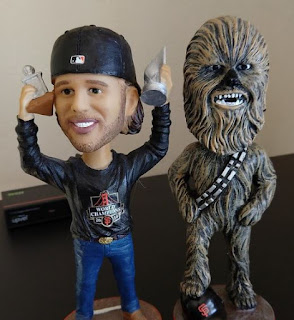By Steve Sanders
 |
| Image courtesy flickr |
You’ve no doubt seen them sitting on a friend’s coffee
table or on the corner of a cubicle. At
first glance they may appear to be curios or stylized statuettes of people,
animals or cartoon characters. However,
should you touch them, these miniature caricatures do something that no other
figurines do: Their heads wobble, or
more precisely bobble. While bobbleheads
are known for bringing a smile to even the most stoic of individuals, what most
people fail to realize is just how long they’ve been around.
Made in China
While the majority of bobbleheads produced today are made in China, so
too were the first iteration of the genre.
While the Revolutionary War raged in the colonies in the 1770’s, so too
did the yen for what were then called nodding-head figurines that were imported
in large numbers from Canton to England and America. While there was no mention of bobble-headed
depictions of George Washington, figurines of Buddha and other religious icons
called temple-nodders were quite popular.
Unlike today’s plasticized bobbleheads, those made in the eighteenth and
nineteenth centuries were made of fine porcelain. By the mid-nineteenth century, most of the
bobbleheads sold in the US were produced in Germany. By then the range of subject matter had
changed from idols to animals like porcelain dogs and cats that soon became all
the rage. So much so that in 1842,
Russian writer Nikolai Gogol first made mention of a bobblehead in short story
entitled The Overcoat. In the opening
page, he described the story’s protagonist Akaky as having a neck that was,
“like the neck of a plaster cat which wags his head.”
While the popularity of bobbleheads waxed and waned for the next hundred
years, it never faded to obscurity.
During the Roaring Twenties, New York Knicks basketball bobbleheads were
a hot commodity for several years, only to see interest in them evaporate
during the Great Depression. Interest in
bobbleheads didn’t gain ground again until the 50’s. But it was in the 1960’s that bobblehead mania
took hold with a vengeance.
MLB Bobbleheads?
 |
| Image courtesy flickr |
In
1960, Major League Baseball commissioned a series of papier-mache bobbleheads
of each team as giveaway items for fans.
Made in Japan, these bargain basement bobbleheads all sported the same
cherubic face which bobbed above team jerseys.
It wasn’t until the 1960 World Series that the league introduced
bobbleheaded replicas of baseball players Mickey Mantle, Roger Maris, Willie
Mays and Roberto Clemente. Those same freebie
bobbleheads today are worth $400-$800 depending on their condition.
Of
course, sports wasn’t the only place where bobbleheads made their mark during
the sixties. No sooner did Beatlemania
arrive on our shore when bobblemania took over as a set of the Fab Four bobbleheads
were marketed both here and abroad.
While the original four retailed for a few dollars, should your
grandparents have a set squirreled away somewhere in their attics, they’d fetch
anywhere from $300-$900 today.
By
the 1970’s interest in bobbleheads had all but faded into obscurity,
overshadowed by such things as the Vietnam War and Watergate. While Disco may have died in 1980, it wasn’t
until the 90’s when bobbleheads bobbed back to life once more. Advances in plastic production technology
meant that bobbleheads could be produced in quantity for much less money than
the traditional ceramic process that had held sway for centuries. To increase their collectability,
manufacturers took to creating limited issue bobbleheads. It wasn’t long before baseball came to the
rescue once more as the San Francisco Giants gave away bobbleheads to the
35,054 fans who watched them lose 3-2 to the Milwaukee Brewers on Sunday, May
9, 1999.
Bobbleheads in the 21st Century
 |
| Image courtesy flickr |
The
turn of the century saw a resurgence of bobblehead popularity. The low cost of manufacture meant bobbleheads
soon included everything from cultural icons like Michael Jackson and James
Dean to media sensations like model Anna Nicole Smith. Even Britain’s royals have been immortalized
as bobbleheads, with Princess Diana and the 2011 royal wedding of Prince
William and Catherine Middleton being among the most popular.
While
bobblehead popularity has grown, by the year 2002, the size of bobbleheads had
shrunk with the introduction of the mini-bobblehead. Two to three inches tall, they were
popularized when Post Cereals included some 22 million free mini bobbleheads of
MLB players in popular brands of their cereal before opening day that same year.
It
wasn’t until November 18, 2014 that bobbleheads reached a new milestone when it
was announced that the National Bobblehead Hall of Fame and Museum was slated
to open its doors in 2016 in Milwaukee, Wisconsin. From January 7thru April 30, 2016 a preview
exhibit of bobbleheads was shown at RedLine Milwaukee. The exhibit was touted as “The largest public
display of bobbleheads in history.” To
say that bobbleheads had finally garnered a little wobbly respect was to put it
mildly. The previous year saw the
introduction of the Pope Francis bobblehead that created such a demand that
there was soon a nationwide shortage. It
was also the same year that National Bobblehead Day was inaugurated in the
US. If you missed that announcement in
the media, maybe you caught the one the following year when the Guinness Book
of World Records issued a record for the world’s largest bobblehead for a 15 ft
4.75 inch tall bobblehead named Goldie.
The future of bobbleheads
Today
it’s possible to get personalized bobbleheads made in your own image or those
of family and friends. While it’s
unclear of where the bobblehead will pop up in the future, one thing is
certain. It’s hard to keep a good
bobblehead down.

Comments
Post a Comment